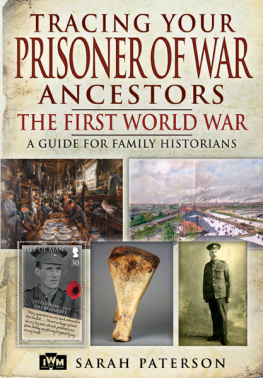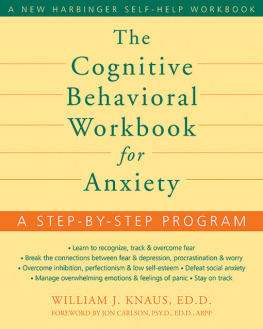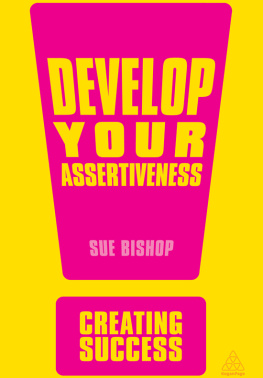Assertiveness Workbook
New Harbinger Publications
Publishers Note
This publication is designed to provide accurate and authoritative information in regard to the subject matter covered. It is sold with the understanding that the publisher is not engaged in rendering psychological, financial, legal, or other professional services. If expert assistance or counseling is needed, the services of a competent professional should be sought.
Distributed in Canada by Raincoast Books
Copyright 2000 by Randy J. Paterson
New Harbinger Publications, Inc.
5674 Shattuck Avenue
Oakland, CA 94609
Cover design by SHELBY DESIGNS & ILLUSTRATIONS
Edited by Jueli Gastwirth
Text design by Tracy Marie Powell
Library of Congress Card Catalog Number: 00-134792
ISBN-10 1-57224-209-4
ISBN-13 978-1-57224-209-4
All Rights Reserved
New Harbinger Publications website address: www.newharbinger.com
For Geoff

Contents

This workbook is based, in part, on a group assertiveness training program, entitled Being There, that was developed for the Changeways Program at Vancouver Hospital and Health Sciences Centre in Vancouver, British Columbia. Many people were involved in the development of this program and deserve thanks. Rosanne Wozny participated in client recruitment and assessment and has assisted in the development of the program from its inception. Shelley van Etten, Martin Carroll, and Lindsey Jack all provided invaluable feedback on the program and helped structure some of the exercises that have found their way into this workbook. Elizabeth Eakin assisted on the clerical side with the preparation of materialsand by keeping us all organized.
Merv Gilbert at Vancouver Hospital has been extremely supportive of the Changeways program and of my work generally. To him, my thanks. I would also like to thank Bill Newby and Richard W. J. Neufeld for their strong, valued, and lasting impact on my career and my work. Jueli Gastwirth at New Harbinger Publications provided invaluable feedback in the preparation of this book, for which I am very grateful.
Finally, our clients at Changeways have assisted immeasurably through their participation in early versions of the program, tolerance for the challenges of program development, feedback about exercises and material that worked and did not work, support for the project, and inspiration and anecdotes. This manual could not have been written without their help.

Being There
Two kinds of people pick up books on assertiveness. Some want to polish their image. They have a face they present to the world, and sometimes it cracks. Sometimes the mask falls off. Sometimes people see through it. They want to learn how to hold the mask more firmly, how to present it more rigidly, how to prevent others from seeing them so easily. They have rejected themselves, and they have decided that they want to preserve the personality (or lack of it) that they display to the world. Often they want to learn how to control others more effectively. How to push others to agree with them, see their way of doing things, do it their way.
Some of the skills in this book may help these people in their quest. But the book isnt written for them. At least, its not written to help them in the way they want to be helped.
Assertiveness isnt about building a good disguise. Its about developing the courage to take the disguise off. Its designed to help the other group of people. The ones who have already tried wearing a mask and have found they cant breathe very well with it on. They want to go out into the world naked-faced, as themselves, but not defenseless. They want to be themselves in a way that doesnt push others off-stage. In a way that invites the people they meet to be more fully themselves too.
Assertiveness, then, is about being there.
Many people in todays society fear conflict and criticism. They believe that in any conflict they would lose and that any criticism would crush them. They feel that they have no right to impose their viewsor for that matter, themselveson the world. They have been trained from childhood to believe that their role is to accept and live up to the standards that other people impose. Being visible, being flawed, holding opinions, or having wishes of their own all leave them open to attack.
Is this you?
The solution is to be invisible. To offer no opinion until others have done so, and then only to agree. To go along with any request. To impose no boundaries or barriers. To prevent yourself from ever saying no. To give up on directing your own life. To pacify those who might disapprove of you. To hide your ideas, your dreams, your wishes, and your emotions. To dress, act, and live in order to blend into the background and disappear. To exist not so much as a person, but as a mirror for other people: reflecting back their ideas, their wishes, their expectations, their hopes, and their goals. To reflect and thereby vanish. Anything to keep yourself from really being there.
Unfortunately, this solution does not really work. Humans are not meant to be invisible, nor to live as reflections of the lives of others. Extinguishing the self is not an option. It leads to greater fear, more helplessness, sharper resentment, and deeper depression.
Other people see life as little more than a competition. If they are not to become invisible themselves, then others will have to be invisible. There is no choice. Their views must be accepted. Their wishes must be honored. Their way must be everyones way. And should anyone not give in, the anger will flow. The issue will be forced, and the wishes, hopes, and desires of others will be ignored or trampled. To be there, other people (with their inconvenient attitudes and opinions) will have to be absent.
Is this you?
The competitive approach doesnt work either. The anger is never really satisfied. When others give in, it is never joyfully. And they begin drifting away to the exits, leaving the angry person alone to resent the desertion. The effort to control others makes life uncontrollable.
The real solution? To be there. Not to be perfect. To expose our flaws, our irrational emotions and opinions, our strange preferences, our incomprehensible dreams, our unaccountable tastes, and our all-too-human selves to others. To be there. Not so that others will bow down to us or hide themselves from us, but in a way that invites others to be there as well. A way that acknowledges the right of everyone to be every bit as irrational, flawed, and human as we are.
Assertiveness is all about being there.
In this workbook you will learn about many of the basic skills and ideas involved in being more fully present in your world and your life. Many of these skills you already know. Some may be new. Bringing them into your life will take practice and effort.
Ready?
Dont Read This Book
Perhaps you are wondering what good reading this book will do you. Lets end the suspense early. Not much. Perhaps you will learn more about assertiveness. You may recognize assertive strategies in others more readily. You may become more able to classify your own behavior as assertive or otherwise.

















